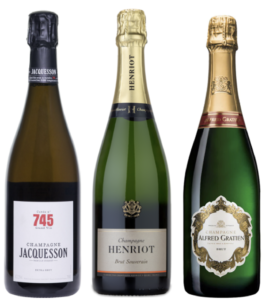If we asked you to name ten Champagne houses, without giving it any thought, we’d bet your initial choices would include some or all of Moet & Chandon, Mumm’s, Taittinger, Veuve Cliquot, Pommery…and then you’d slow down a bit. Oh, yes, Perrier-Jouet, Pol Roger…a little more thought and maybe you’d come up with Roederer, Deutz or Piper-Heidsieck, to round out the ten. Or maybe not.
The point is that for most of us, our knowledge of Champagne is restricted to a handful of the biggest names, the ones that are always available and occupy the most shelf space in our local wine stores. But there are more than 2,000 producers of real French Champagne, of which approximately 370 are considered the Grandes Marques, the most prestigious of them all. Now, very few of us have tasted anything close to 370 Champagnes, much less 2,000 of them. So, if you have the chance to taste a Champagne other than the very few at the top brands in terms of popularity, it will be something new to your taste buds.
We have four categories of Champagnes: the super premiums, the top sellers, the “oh, yeah, I’ve heard of them”, and then the truly small, little known producers. The super premiums include wines such as Dom Perignon from Moët et Chandon, Krug Crystal and Comtes de Champagne from Taittinger. These cost a lot and are hardly for routine drinking unless you own a hedge fund or are a Russian oligarch. More frequently, we buy the wines that we know, the ones on the list of ten we challenged up front, because…well, because we know them.
There are plenty of Champagnes in that third category, which you may have heard about. These might include Lanson, Nicolas Feuillatte or Philliponat. They tend to be a bit less expensive than the Big Names (English for Grandes Marques) and some are excellent. But some are somewhat disappointing. So if you decide to be a little adventurous and try some Champagne you’ve never tasted before, why not go all the way and get one of the Petites Maisons, or little houses? We think you’ll be well served doing so.
We’ve written previously about Tribaut Schlosser, a favorite of ours. Others might include Alfred Gratien, Henriot, Jacquesson and Duval-Leroy. Whether these fall into category 3 or 4 depends on your familiarity with Champagne wines. With more than 2,000 more to choose among, there are bound to be more than a few – a lot more – that you’ve never heard of or tasted.
Why try something you don’t know? For the same reason you try the new restaurant that just opened in your neighborhood or the new flavor of ice cream. Maybe you’ll love it; maybe you won’t. But the upside chances outweigh the negatives. The worst that will happen is you’ll decide not to buy that Champagne again. It’s very rare that you’ll hate any of them and you’ll broaden your knowledge of what the Champagne region has to offer.
So take a chance at your local store. Or to reduce the outlay, try a glass at an upscale bar or restaurant. Or best of all, travel to Champagne. You won’t have any trouble finding Petites Maisons there.
